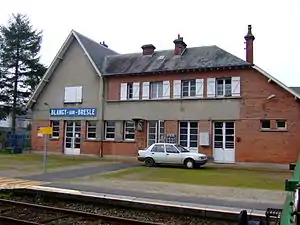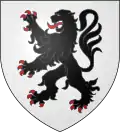Blangy-sur-Bresle
Blangy-sur-Bresle is a commune in the department of Seine-Maritime in the Normandy region of northern France.
Blangy-sur-Bresle | |
|---|---|
 Blangy railway station | |
 Coat of arms | |
Location of Blangy-sur-Bresle 
| |
 Blangy-sur-Bresle  Blangy-sur-Bresle | |
| Coordinates: 49°55′57″N 1°37′46″E | |
| Country | France |
| Region | Normandy |
| Department | Seine-Maritime |
| Arrondissement | Dieppe |
| Canton | Eu |
| Intercommunality | CC Aumale - Blangy-sur-Bresle |
| Government | |
| • Mayor (2008–2014) | Claude Vialaret |
| Area 1 | 17.45 km2 (6.74 sq mi) |
| Population (2017-01-01)[1] | 2,972 |
| • Density | 170/km2 (440/sq mi) |
| Time zone | UTC+01:00 (CET) |
| • Summer (DST) | UTC+02:00 (CEST) |
| INSEE/Postal code | 76101 /76340 |
| Elevation | 42–216 m (138–709 ft) (avg. 49 m or 161 ft) |
| 1 French Land Register data, which excludes lakes, ponds, glaciers > 1 km2 (0.386 sq mi or 247 acres) and river estuaries. | |
Geography
Blangy is a small town situated in the valley of the River Bresle – which here forms the border between Normandy and Picardie – some 40 kilometres (25 mi) east of Dieppe in the Pays de Bray. Forestry, farming, and light industry are the main economic activities. The town lies on the D49 and the D928 roads close to junction 5 of the A29 motorway. There is an SNCF railway station from which TER services run to Beauvais and Le Tréport.
Heraldry
 Arms of Blangy-sur-Bresle |
The arms of Blangy-sur-Bresle are blazoned : Argent, a lion sable, armed and langued gules. |
Population
| Year | 1962 | 1968 | 1975 | 1982 | 1990 | 1999 | 2006 |
|---|---|---|---|---|---|---|---|
| Population | 2925 | 3336 | 3404 | 3456 | 3447 | 3404 | 3221 |
| From the year 1962 on: No double counting—residents of multiple communes (e.g. students and military personnel) are counted only once. | |||||||
Places of interest
- The church of Notre-Dame, dating from the thirteenth century.
- The Manoir de Fontaine (1607).
- The Manoir de Penthièvre (1636), built for la Grande Mademoiselle.
- The seventeenth century fulling mill at Hollande
- The Manoir de Grémontmesnil (1776).
- The mill at Hottineaux 1800).
- The remains of a medieval castle.
- Three museums.
Notable people
- Anne Marie Louise of Orléans (1627–1693), la Grande Mademoiselle.
References
- "Populations légales 2017". INSEE. Retrieved 6 January 2020.
| Wikimedia Commons has media related to Blangy-sur-Bresle. |
This article is issued from Wikipedia. The text is licensed under Creative Commons - Attribution - Sharealike. Additional terms may apply for the media files.